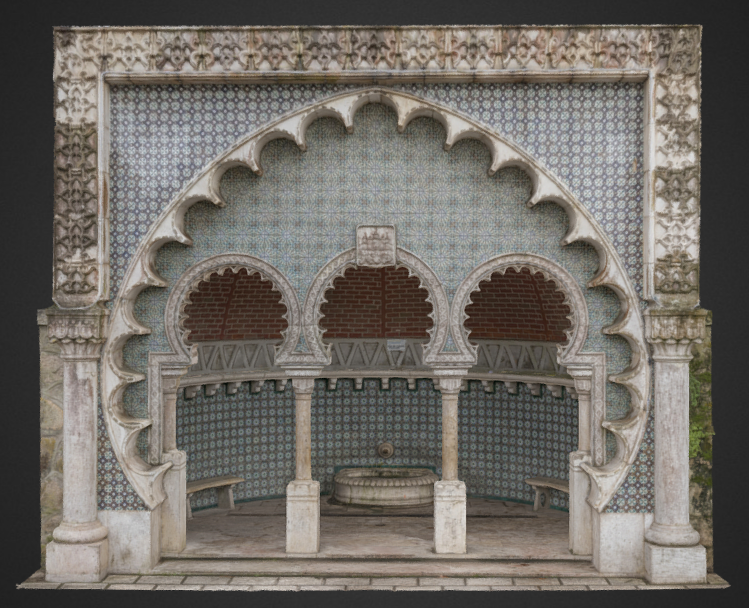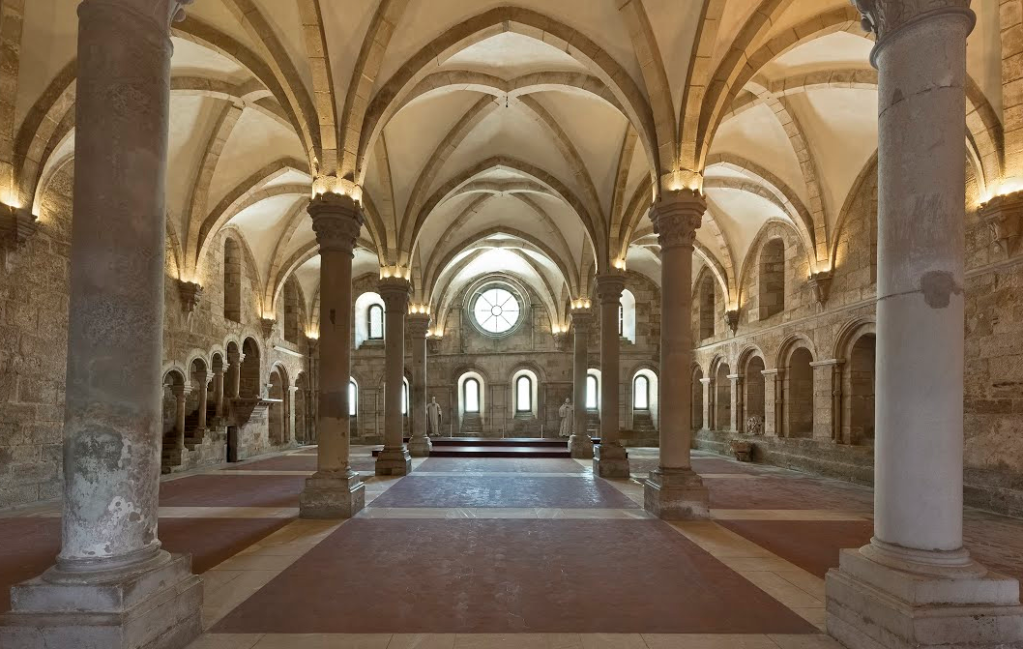A collection of 3D models of architecture and objects in Spain and Portugal. Click directly on the image or its name to be redirected to the 3D model’s site: with a mouse try click and dragging, double-click and dragging, or moving the scroll wheel; on a touch screen drag with one or two fingers, or pinch/expand with two fingers to zoom in/out. ARTES takes no credit for the production of any of these models, and we are hugely grateful to all those who have shared their models on Sketchfab and other platforms.
Our aim is to ensure that all models are accompanied by a brief text and bibliography: please do send us recommendations of other models to include!
Spain
Andalusi Objects
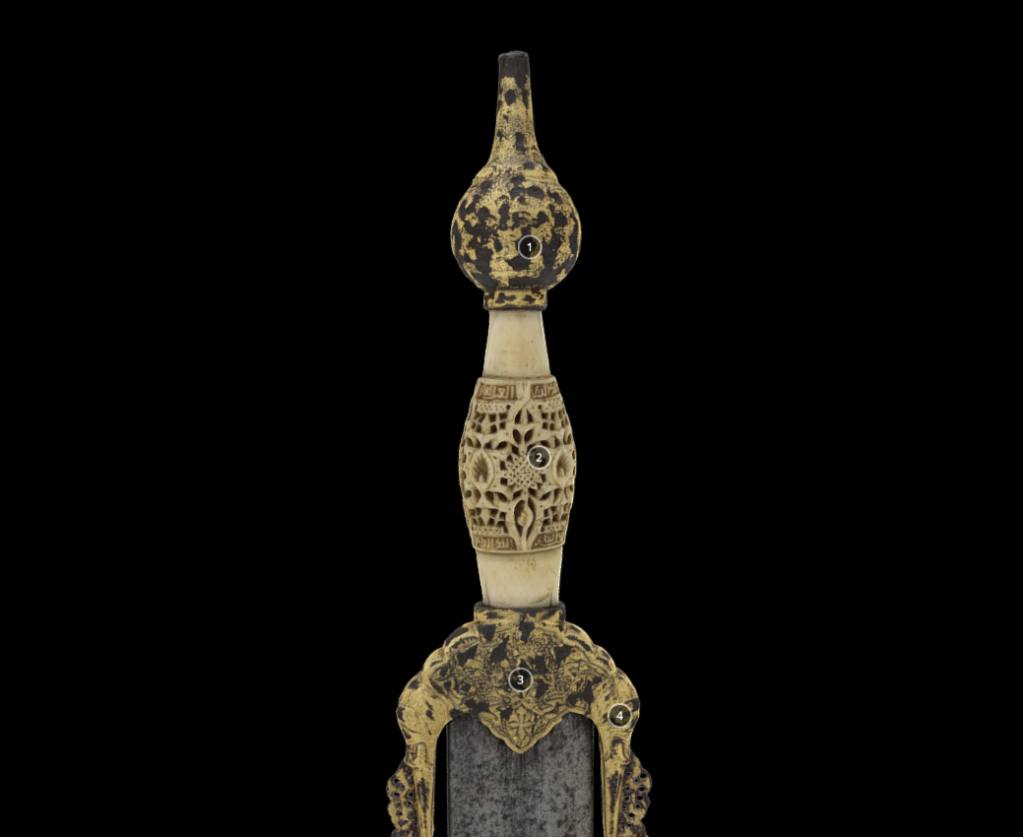
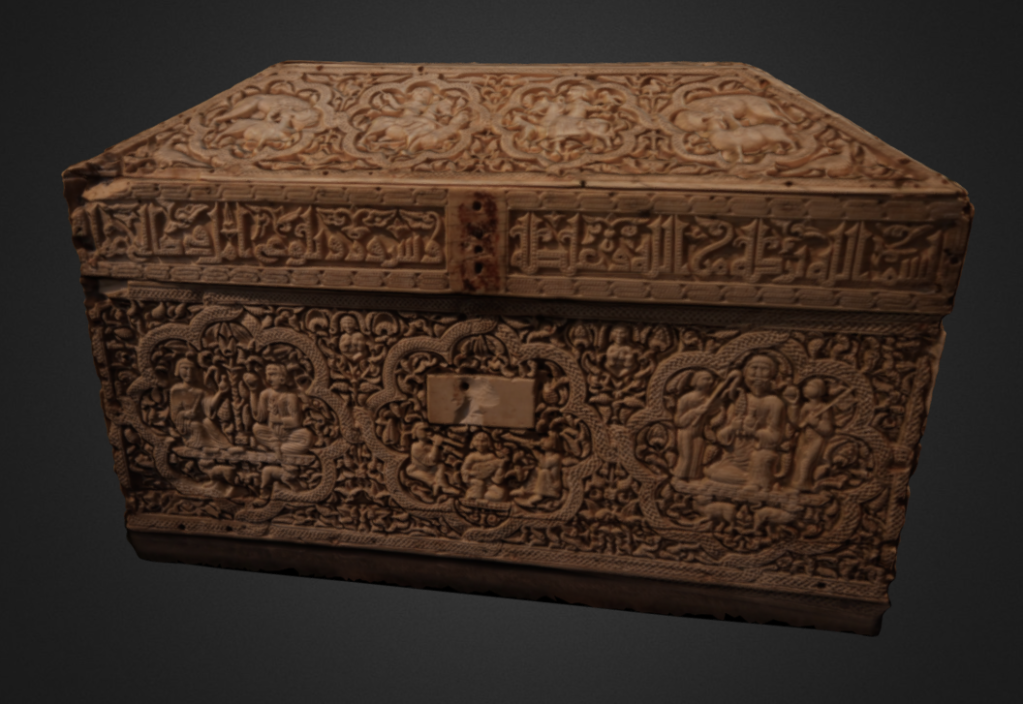
Also known as the Leyre casket, the Pamplona casket has been attributed to approximately 1004-5 AD. It is made from 19 intricately carved ivory panels. it depicts the vegetal motifs and enclosed roundel designs typical of that period. several artists have been attributed to this casket, suggesting it was made in a workshop. It has been suggested that this casket was made for ‘Abd al-Malik al-Muzaffar for his victory in Leon. On the casket we can also see motifs of Islamic princely life, a typical subject matter to be included in Islamic ivory caskets. It is currently housed in the Pamplona Cathedral. (Erin Welds, text)
Leyre mücevher kutusu olarak da bilinen Pamplona mücevher kutusunun yaklaşık MS 1004-5 yıllarına yapıldığı bilinmektedir. Kutu detaylı bir şekilde oyulmuş 19 fildişi panelden oluşmaktadır. Dekorasyonu döneme özgü bitkisel motifler ve yuvarlak çerçeve içindeki sahnelerden oluşmaktadır. Farklı sanatçılara atfedilmiş bu kutunun bu bir atölyede üretildiği tahmin edilmektedir. Kutunun Leon’da kazandığı zaferi tebrik etmek için Abd al-Malik el-Muzaffar için yapıldığı öne sürülmüştür. Kutuda dönemin İslami fildişi mücevher kutularının tipik bir konusu olan asil hayat motifleri de yer almaktadır. Pamplona mücevher kutusu günümüzde Pamplona Katedrali’nde yer almaktadır. (Deniz Vural, translation)
Further reading:
Harris, Julie A. “Muslim Ivories in Christian Hands: the Leire Casket in context Julie A. Harris.” Art History 18, no. 2 (1995): 213-221. http://www.academia.edu/download/7147375/Muslim%20ivories.pdf
Holod, Renata. “Pamplona Casket.” In Al-Andalus: the Art of Islamic Spain, edited by
Jerrilynn D.Dodds, 198-201. New York: The Metropolitan Museum of Art, 1992. https://www.metmuseum.org/art/metpublications/Al_Andalus_The_Art_of_Islamic_Spain
Robinson, Cynthia. “Love in the Time of Fitna: ‘Courtliness’ and the ‘Pamplona’ Casket.” In Revisiting Al-Andalus, edited by Glaire D.Anderson and Mariam Rosser-Owen, 99-112. Leiden: Brill, 2007. https://books.google.com.tr/books?id=2Pb1lzB_Y4YC
Islamic textile from the Monastery of San Zoilo, Carrión de los Condes:

Located between the kingdoms of Castile and León, the Monastery of San Zoilo was a powerful religious center during the 11th and 12th centuries. The blue silk textile from the Monastery of San Zoilo in Palencia, dating from the 11th century, is unique in its impeccable state of preservation and its immense size (2.75 x 2.08m). The fabric with blue background was regarded as a special color in Al-Andalus.
Because of its huge size, this silk fabric is supposed to be a mural decoration hanging on the front of the altar. There are 36 double-headed lion-claw eagle monsters depicted on silk fabrics, which are decorated with complex plant patterns and beaded patterns, with compact layout and magnificent solemnity. (Shentong Zhang, text and translation)
产自圣佐伊洛修道院的伊斯兰纺织品
圣佐伊洛修道院位于卡斯蒂里亚王国与莱昂王国之间,在11到12世纪期间是一个强大的宗教中心。来自帕伦西亚的圣佐伊洛修道院的蓝色丝绸纺织品,年代可以追溯到公元11世纪,其独特之处在于其无可挑剔的保存状态与巨大的尺寸(2.75 X 2.08m)。蓝色背景的织物在安达卢西亚地区被认作是一种特殊的颜色。这件丝织品由于巨大的尺寸而被推测认为是用于悬挂于祭坛正面的壁画装饰物。丝织品上描绘了36只双头狮爪鹰怪,它们被复杂的植物花纹与联珠纹所装饰,布局紧凑,华丽庄严。
Further reading:
Gabriel Y Galán, José Luis. “Dos Telas Islámicas Encontradas En El Monasterio De San Zoilo De Carrión De Los Condes.” Goya, no. 303 (2004): 332-40.
Feliciano, María Judith. “Medieval Textiles in Iberia: Studies for a New Approach.” In Envisioning Islamic Art and Architecture, 46-65. Vol. 2. Arts and Archaeology of the Islamic World. 2014
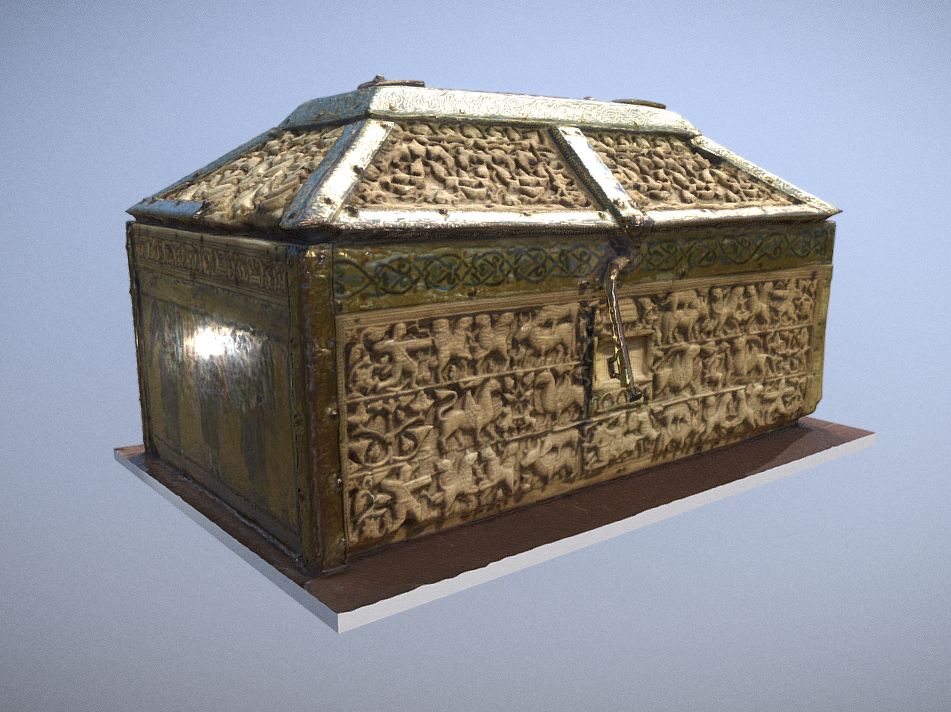

The Zamora Pyxis can be considered among a group of thirty-four surviving ivories dating to the period of 950 to 1050 CE, produced at Madīnat al-Zahrā. The pyxis is cylindrical in shape with a domed lid and produced from an elephant ivory tusk. The décor of the pyxis is rich with both vegetal motifs and iconography. The vegetation consists of palmettes, leaf forms and flowers, while the zoomorphic elements consist of peacocks and birds. These scenes take place along repeated vertical axis, the use of symmetry in décor was regularly employed in the artwork produced at Madīnat al-Zahrā. The inscription on the base of the lid is in Kufic form and shows that the Pyxis was commissioned by al-Hakam II for his concubine Subh. The pyxis was made by Durri al-Saghir (a eunuch adopted by ʿAbd al Rahman III and director of ivory workshop) in 353 after Hijra/ 964 CE. (Warda Malik, text)
Further reading:
http://www.man.es/man/en/coleccion/catalogo-cronologico/edad-media/bote-zamora.html
Anderson, G. D. (2012). Concubines, eunuchs, and patronage in early Islamic Cordoba. In T. Martin (Ed.), Reassessing the roles of women as ‘makers’ of Medieval Art and Architecture (Vol. 7, pp. 633-669). Leiden: Brill.
Prado-Villar, F. (1997). Circular visions of fertility and punishment: Caliphal ivory caskets from al-Andalus. Muqarnas, 14, 19-41.
Santa-Cruz, N. S. (2014). Ivory Gifts for women in caliphal Cordoba: marriage, maternity and sensuality. Journal of Medieval Iberian Studies, 6(1), 103-125.
Asturias

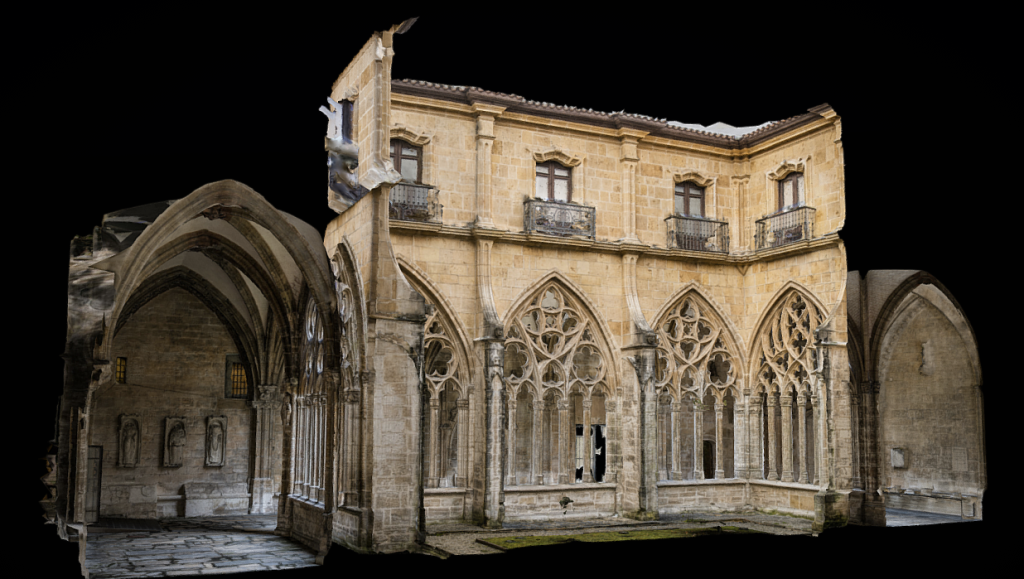
Oviedo cathedral chapter house:


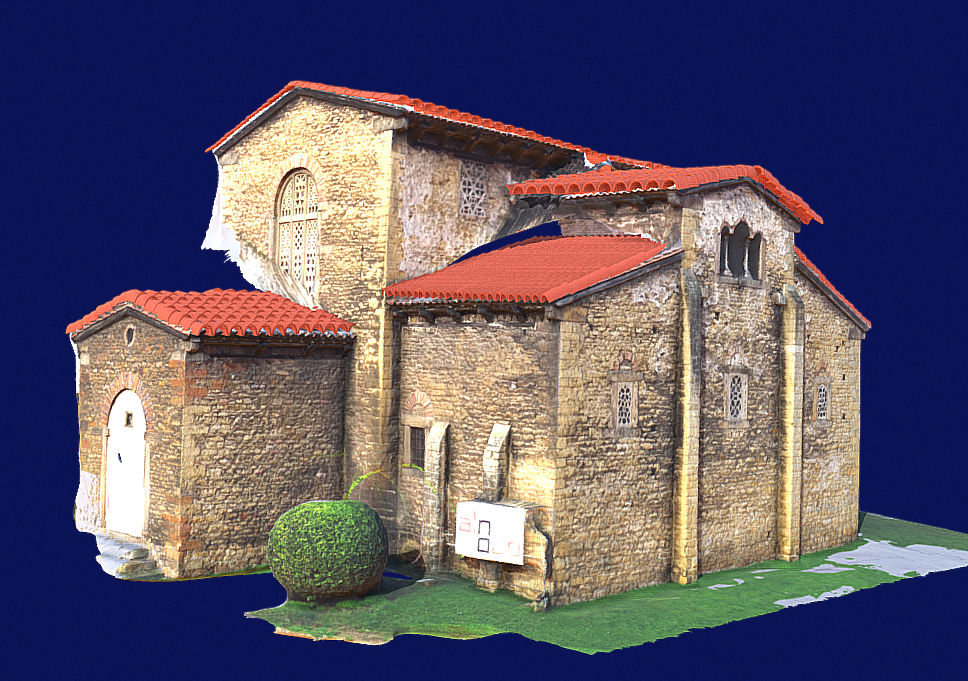
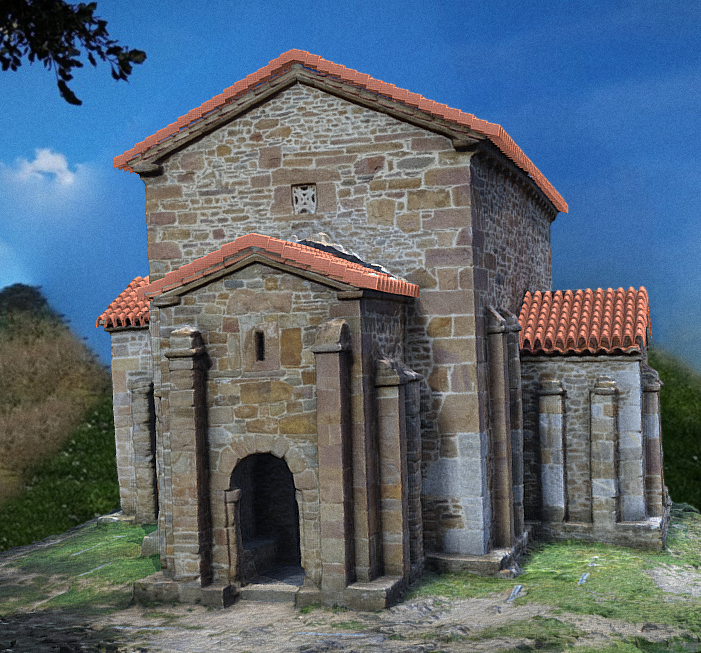
Victory Cross – Cruz de la Victoria:
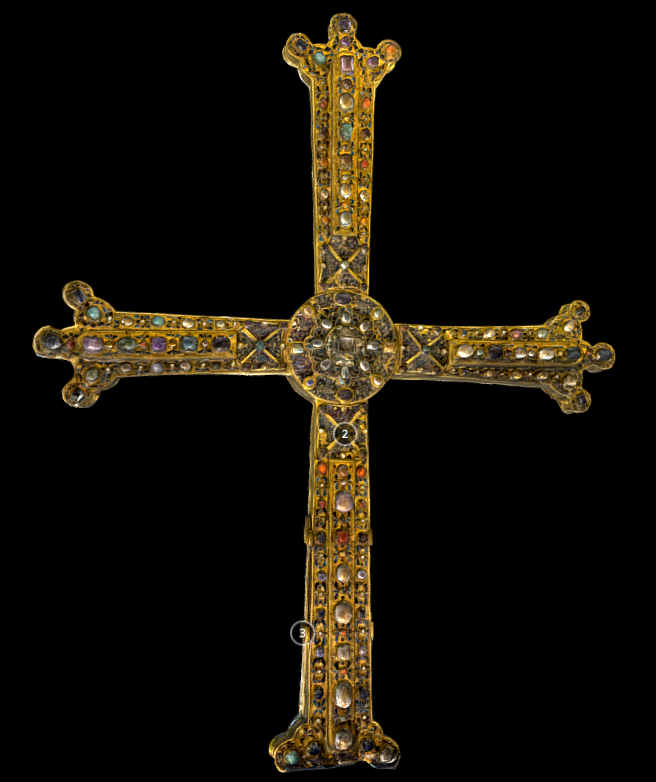
Burgos
Burgos cathedral, Puerta del Sarmental:
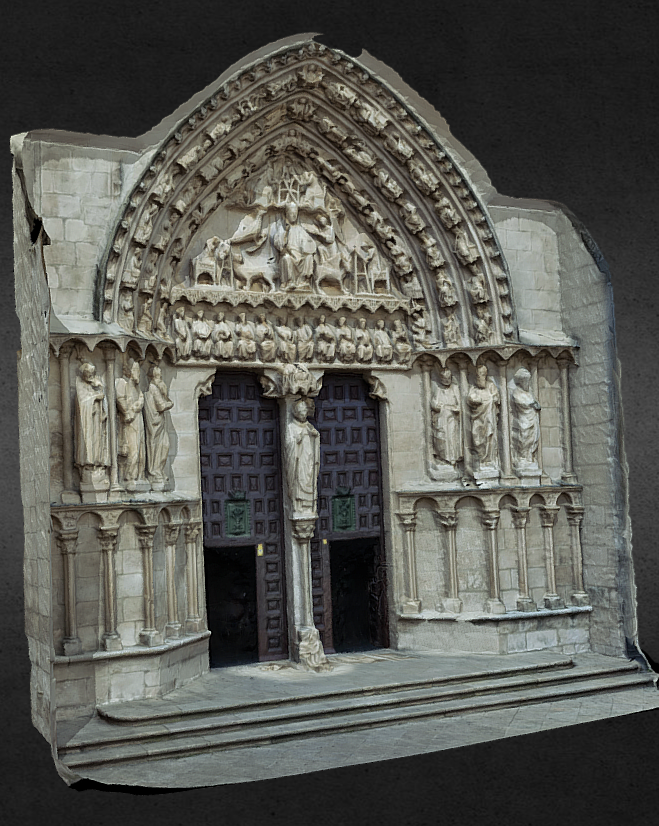
Burgos cathedral, Puerta de la Coronería:
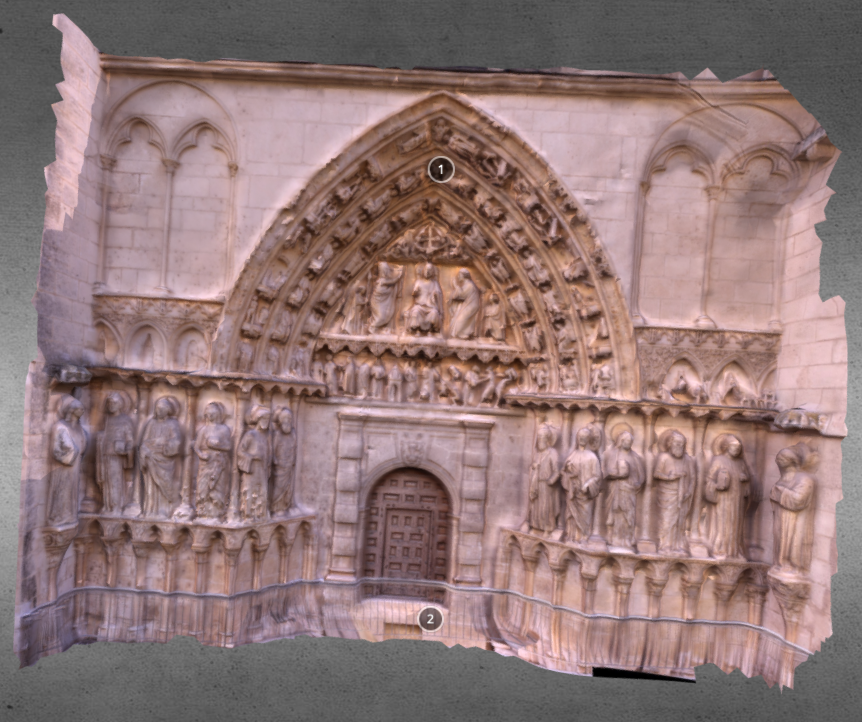
Burgos museum altar frontal, 14c:

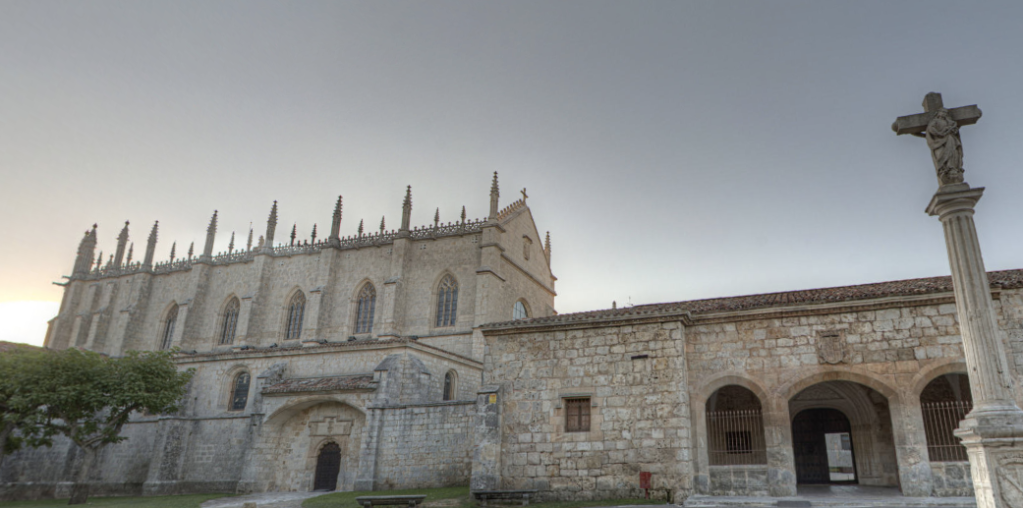
Miraflores, Tomb of Juan II and Isabel de Portugal:
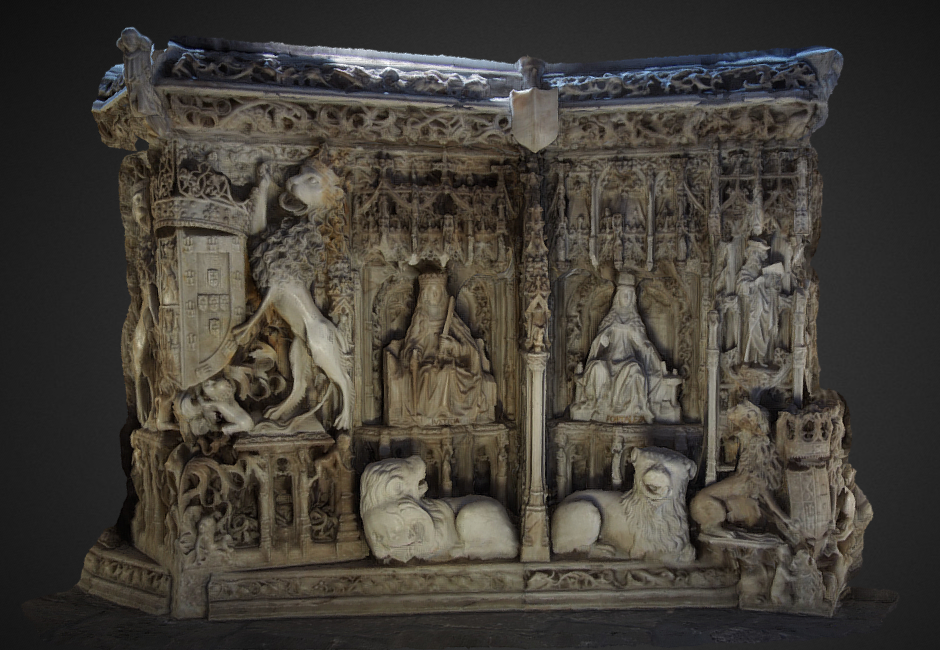
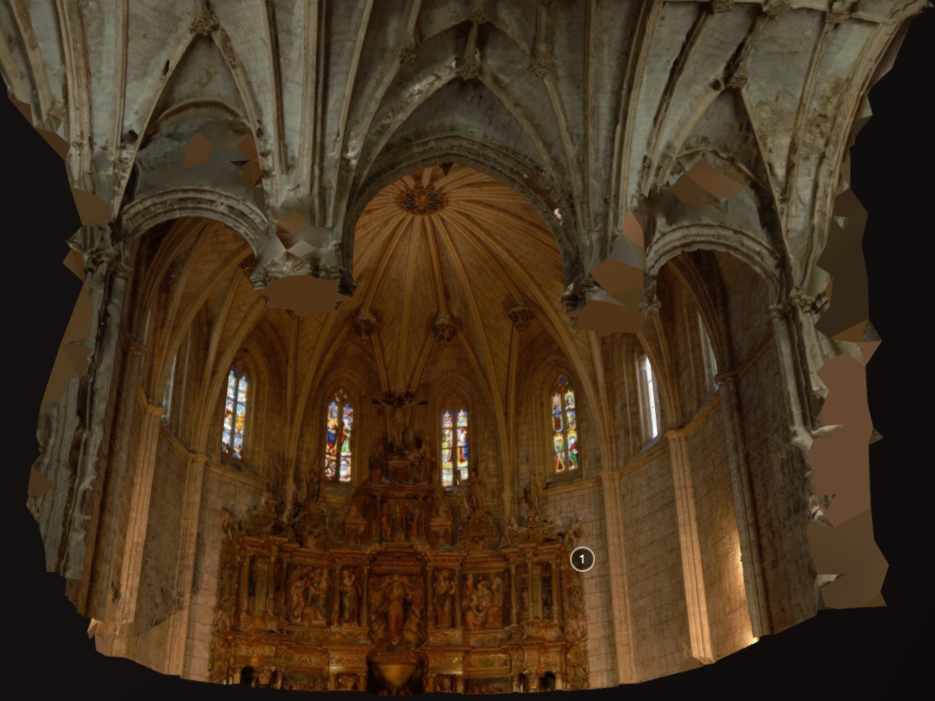
Santo Domingo de Silos – Emmaus/ Thomas:
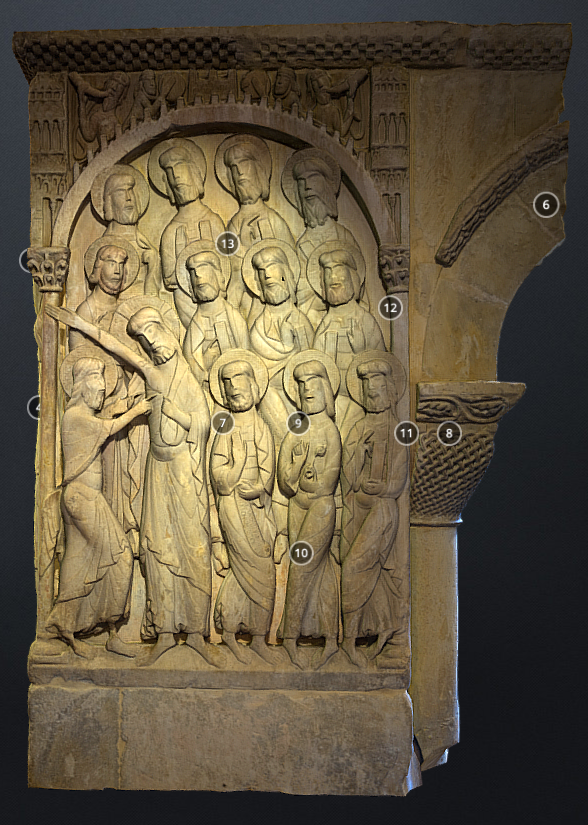
Santo Domingo de Silos – Tree of Jesse:
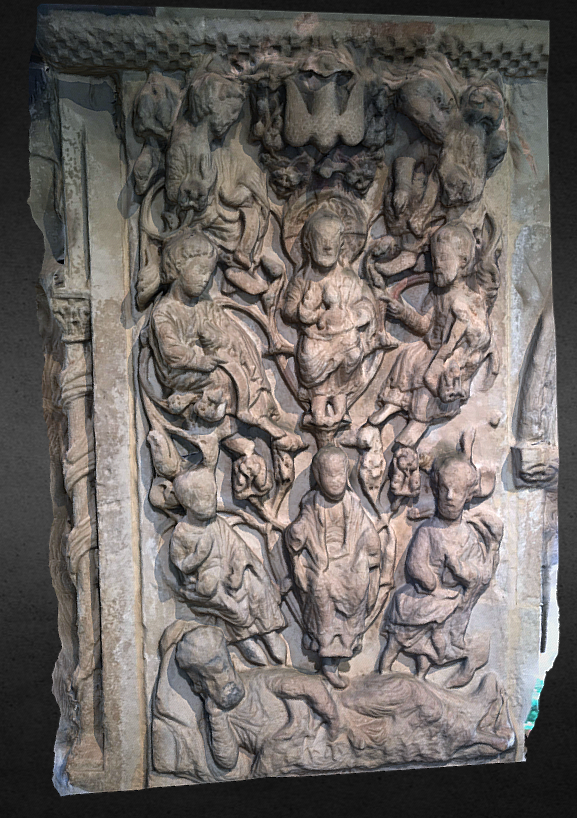
Cordoba
Facade of the Great Mosque of Cordoba:
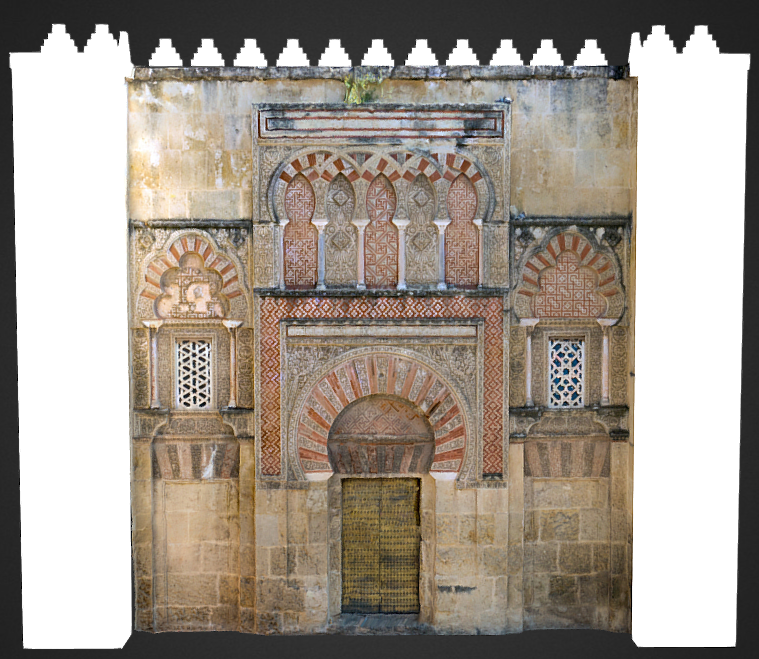

Granada

León
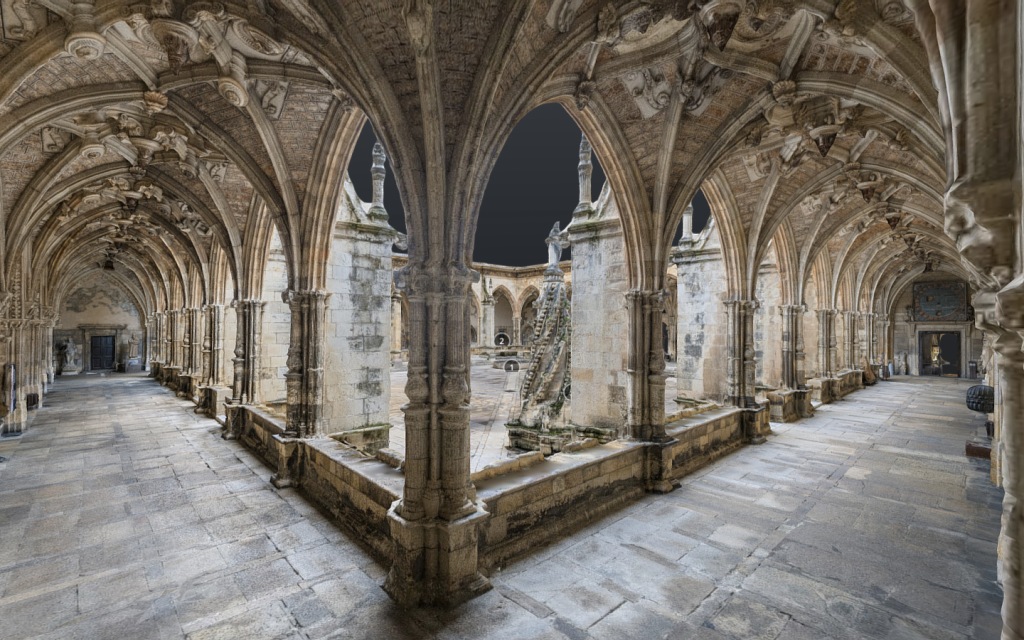
Corner of cloister, León Cathedral:

Nave and presbytery, León Cathedral:
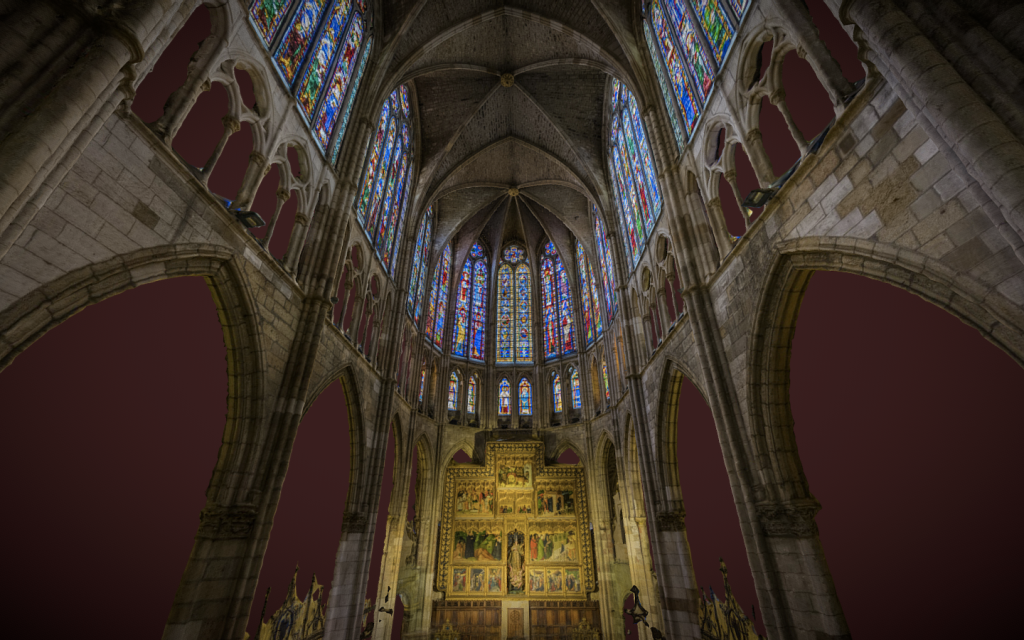
León cathedral preserves more medieval glass than any other Iberian church. Most of what is visible here was made in the 13th and 14th centuries, though there were extensive restorations in the 19th century, and the colours in this image have been artificially enhanced. The Gothic cathedral was begun in the 1250s, and its elevations are strongly indebted to Rayonnant churches in France, especially the new work at Saint-Denis (begun in 1231) and the cathedral in Châlons-en-Champagne. Here at León the vast windows occupy the full width of each bay, and the triforium was fully glazed. The high altar is dominated by the great altarpiece by Nicolás Francés (d. 1468) [Tom Nickson, July 2020]
Further reading:
J. Yarza Luaces, M. V. Herráez Ortega and G. Boto Varela, eds, Congreso Internacional “La catedral de León en la Edad Media”: actas, León 7-11 de abril de 2003 (León 2004)
South transept portal, Leon Cathedral:
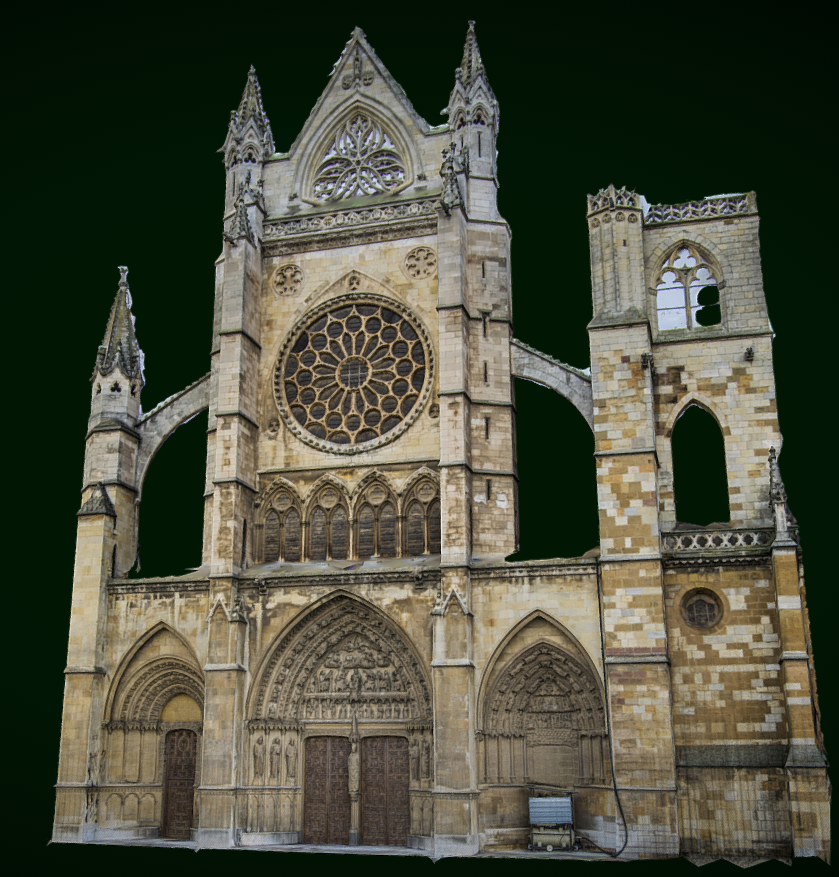
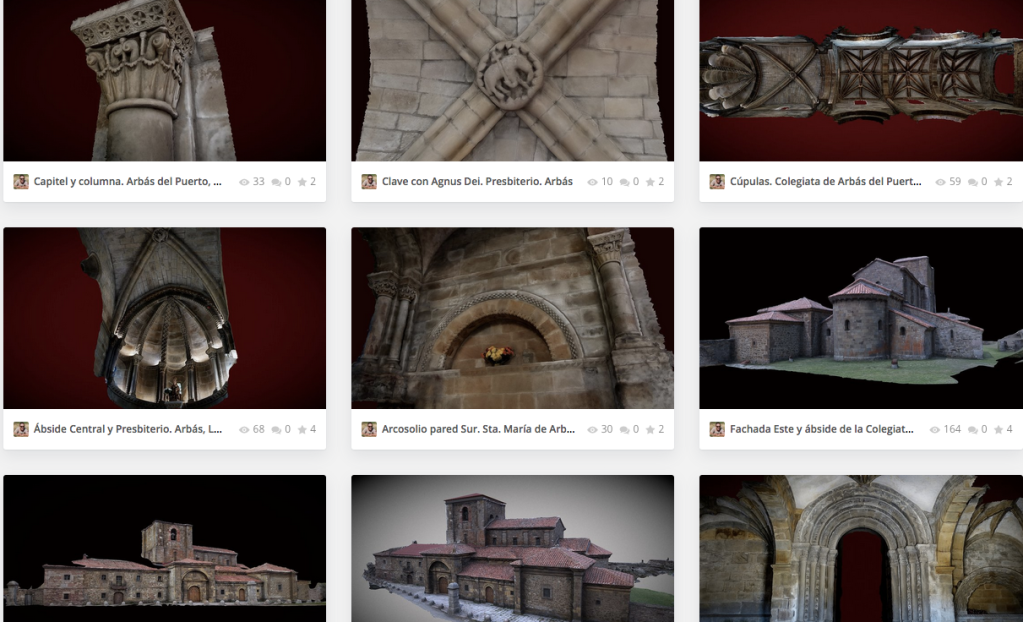
Santa Maria de Gradefes, vaults:


Madrid
Cross of Ferdinand I and Sancha:
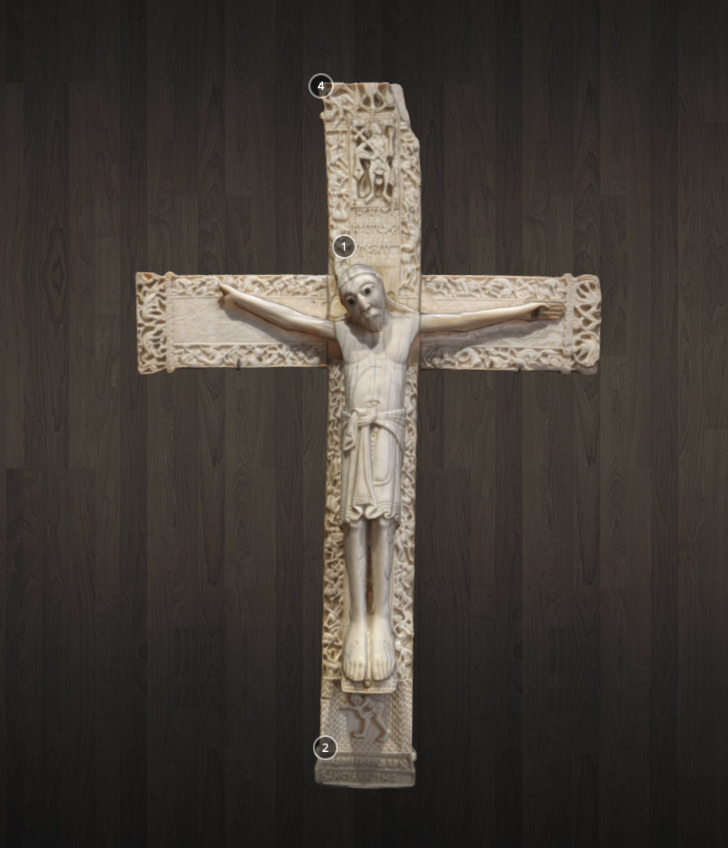

Pamplona
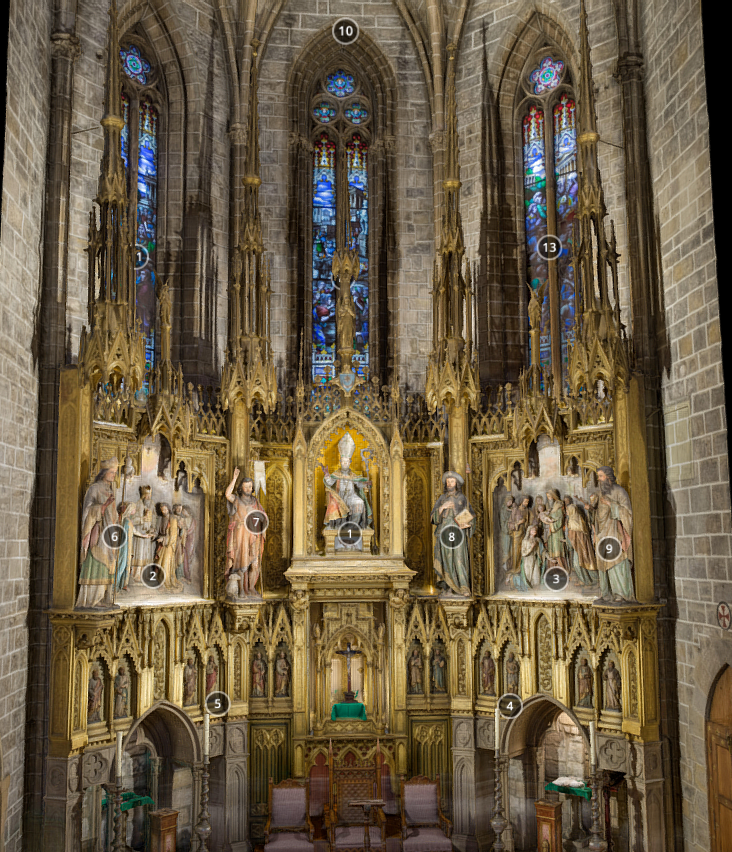
Puerta Preciosa, Cloister of Cathedral of Pamplona:
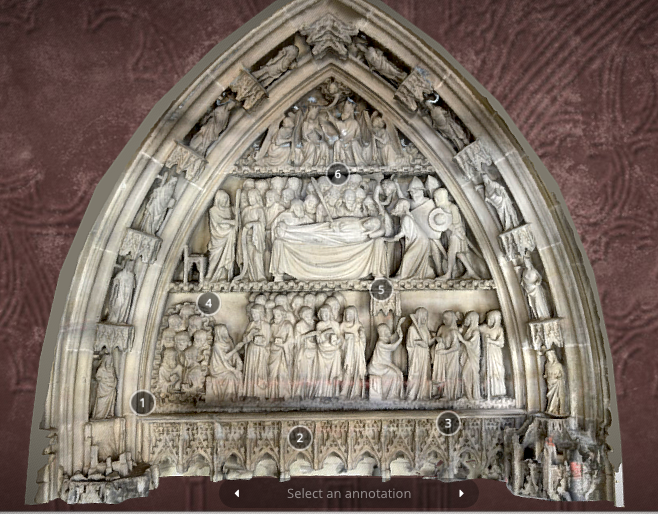
The Puerta Preciosa (c. 1318-1355) served as the threshold between the cloister and the private dormitory of the canons of Pamplona, who lived communally in the cathedral complex until the middle of the nineteenth century. The door’s name derives from a psalm, beginning with the words ‘Preciosa in conspectu Domini…’ (precious in the sight of the Lord…), which was sung by the canons as they retired to their sleeping quarters in a nightly procession. This partial digital reconstruction of the portal shows details from the tympanum, which includes scenes from the end of the life, the death, and the coronation of the Virgin. The inner archivolts visible in the 3D model feature a series of crowned women, standing beneath microarchitectural canopies. Click here for an image of the entire Puerta Preciosa, which includes additional Marian imagery, such as the Annunciation jamb figures. [Jamie Haskell, July 2020]
Further reading:
José Salvador-González, ‘La Puerta Preciosa de la catedral de Pamplona. Interpretación iconográfica fundada en fuentes apócrifas’, Eikón Imago 2(2012): 1-48.
Santiaga Hidalgo Sánchez, ‘El ciclo de la Dormición en el claustro de la catedral de Pamplona’, Revue Mabillon 22 (= t.83) (2011): 145-176.
Santiago de Compostela
Google Arts and Culture Collection on Santiago de Compostela:

Segovia
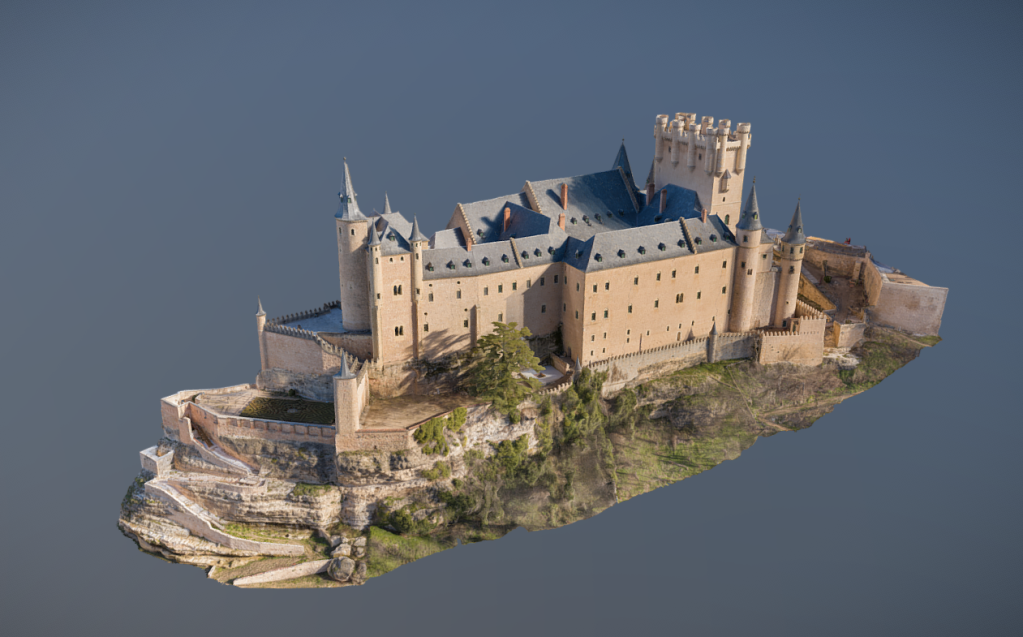
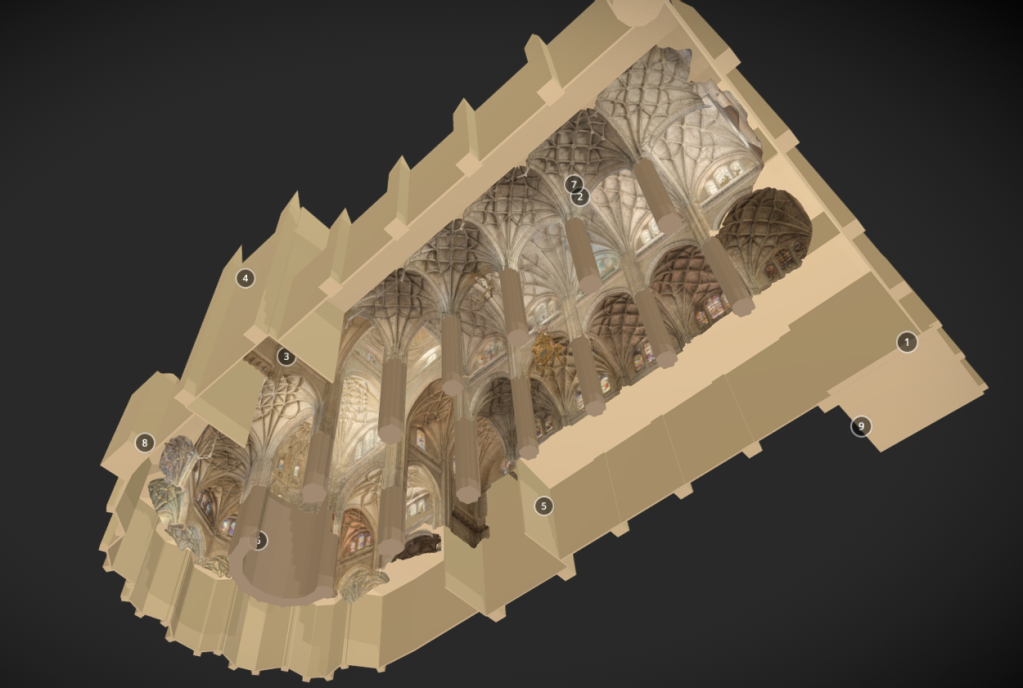

Seville

Patio de las Muñecas, Alcazar, Seville:
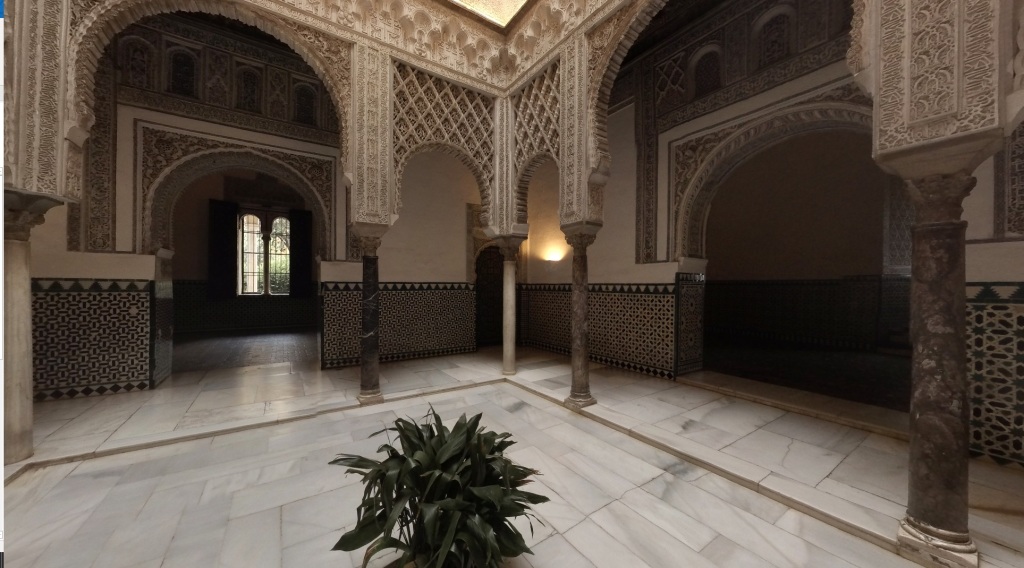
Hall of Ambassadors, Alcazar, Seville:
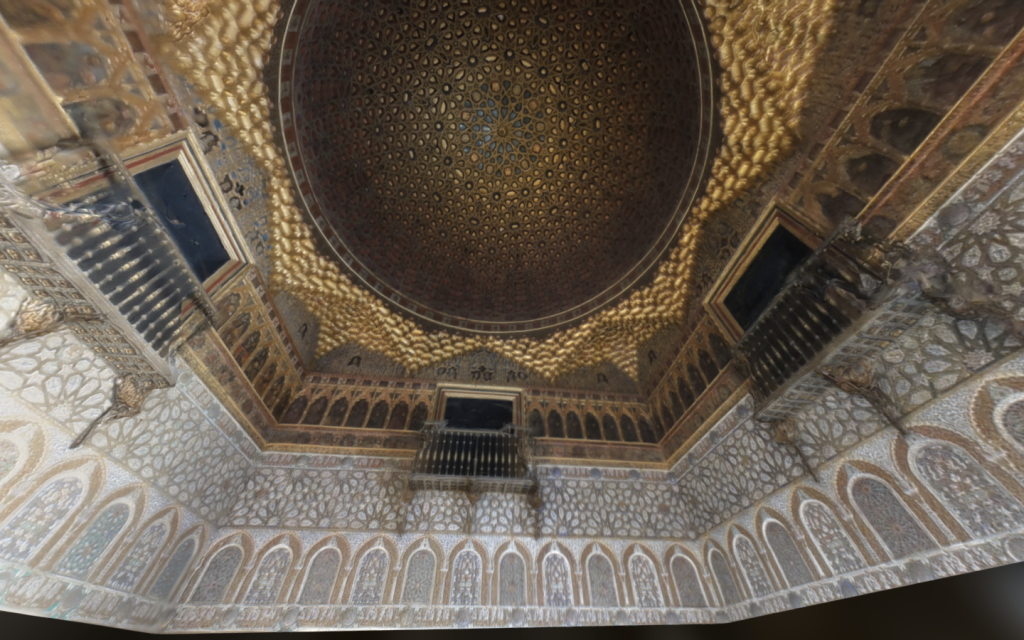
Tarragona
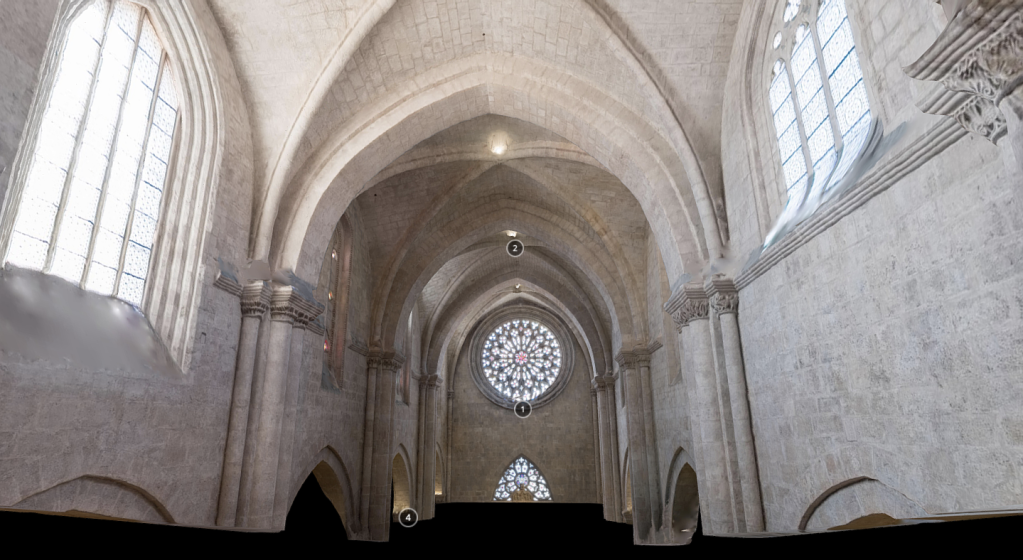
Toledo
San Juan de los Reyes cloister portal:

Tombs from the Capilla de San Blas, Toledo Cathedral:
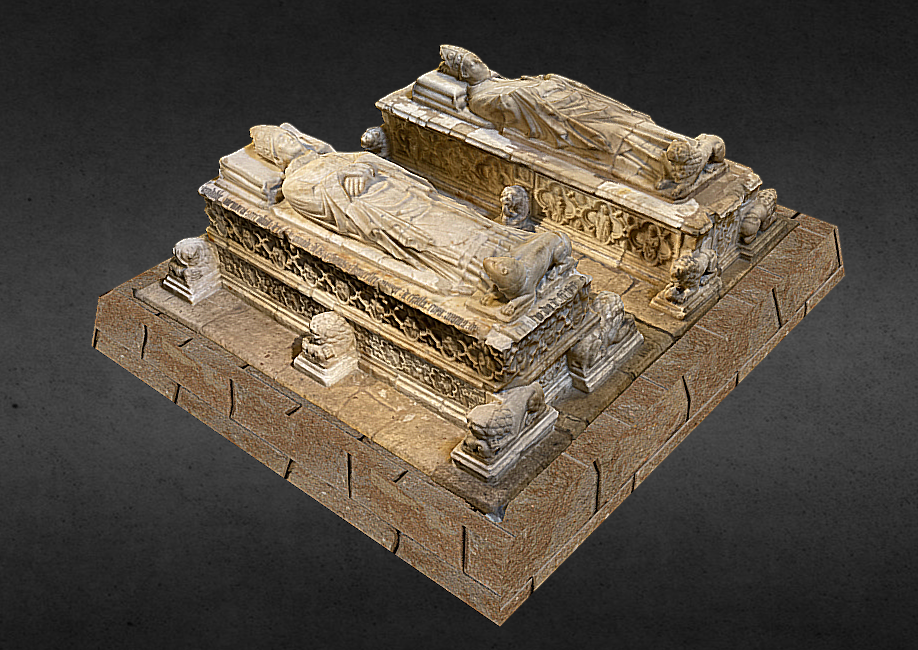

CLICK HERE for a Google Earth guided tour by Dr. Tom Nickson intended to compliment the MAVCOR digital spaces above
Valladolid
Portal of the Colegio de San Gregorio:
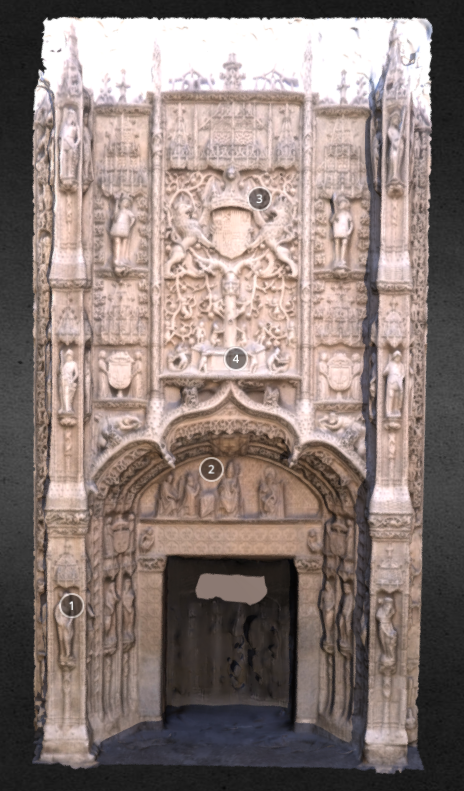
Valencia
Presbytery, Cathedral of Valencia:
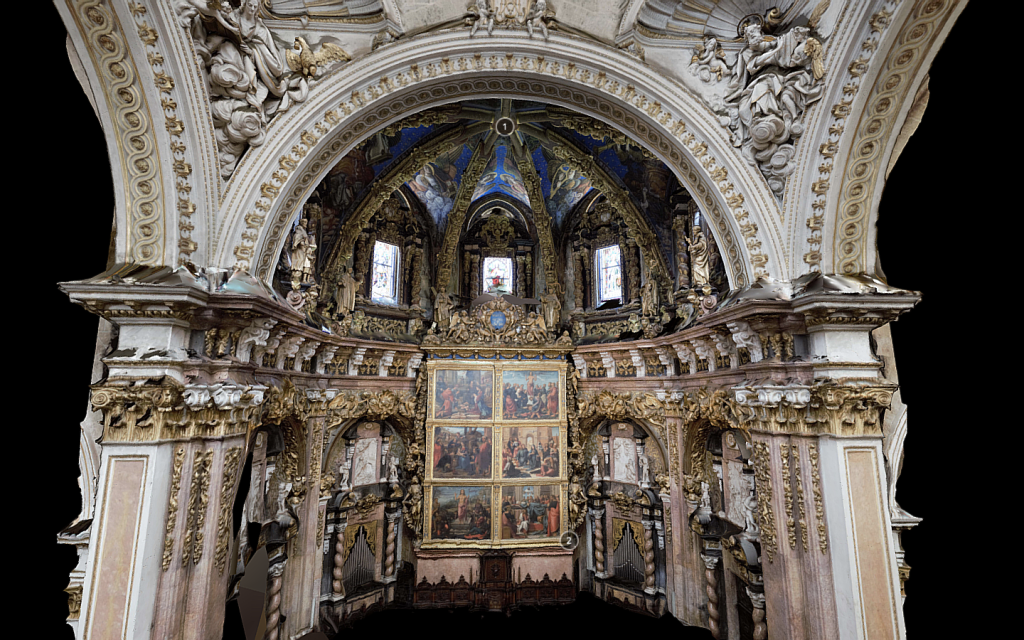
Holy Chalice Chapel, Cathedral of Valencia:

Villalcazar de Sirga
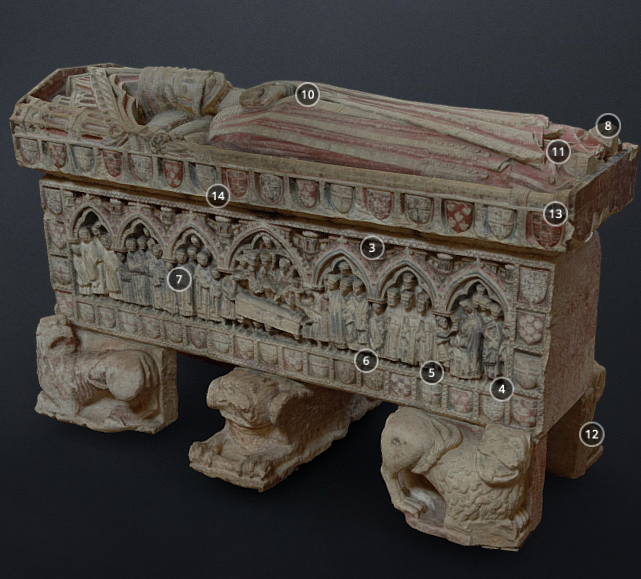
Frieze from Santa María la Blanca, Villalcazar de Sirga:
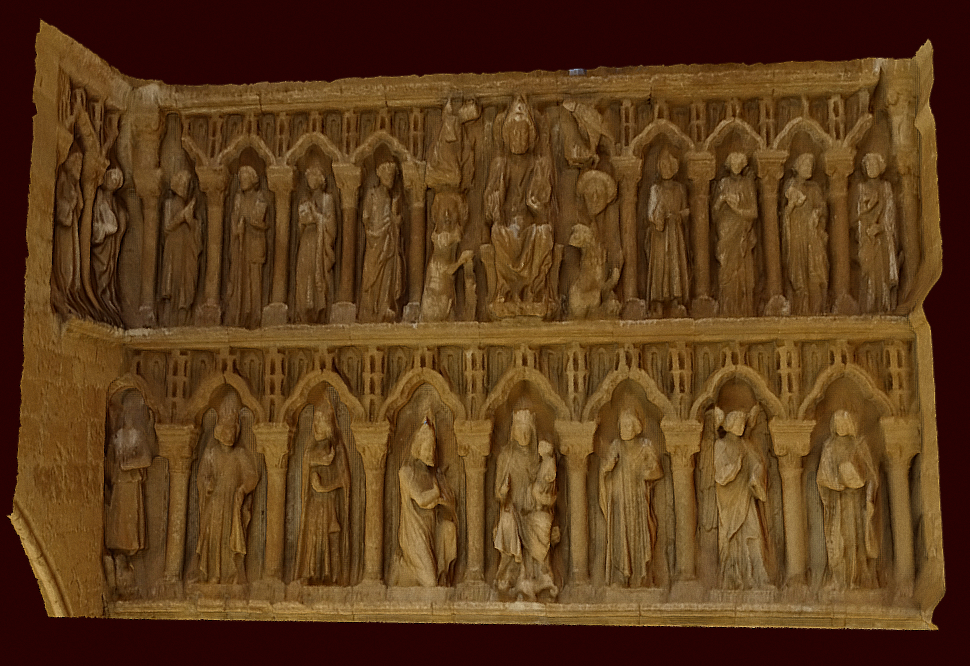
Portal, from Santa María la Blanca, Villalcazar de Sirga:
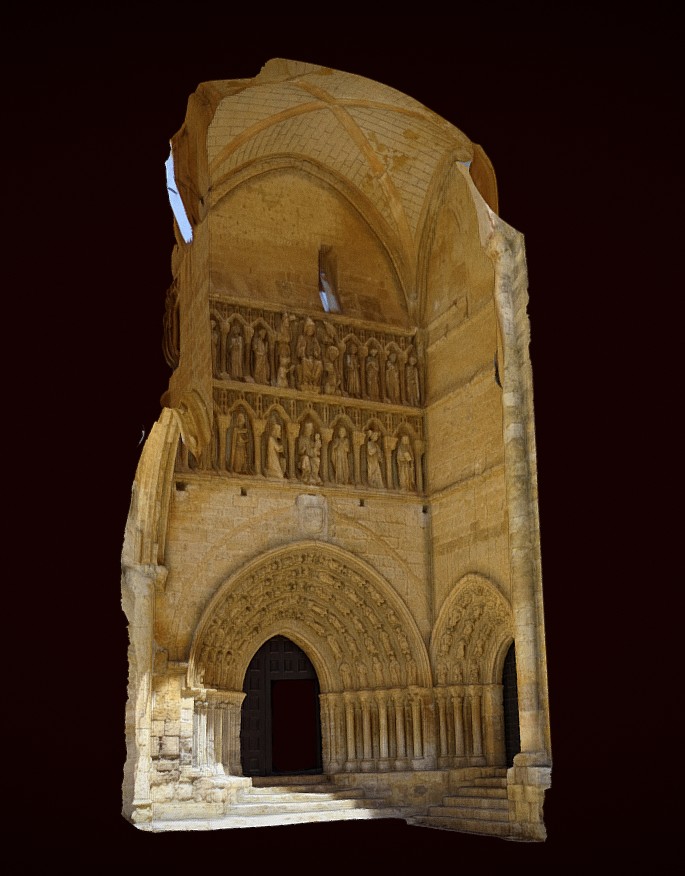
Vitoria
Central Portal, Vitoria Cathedral:
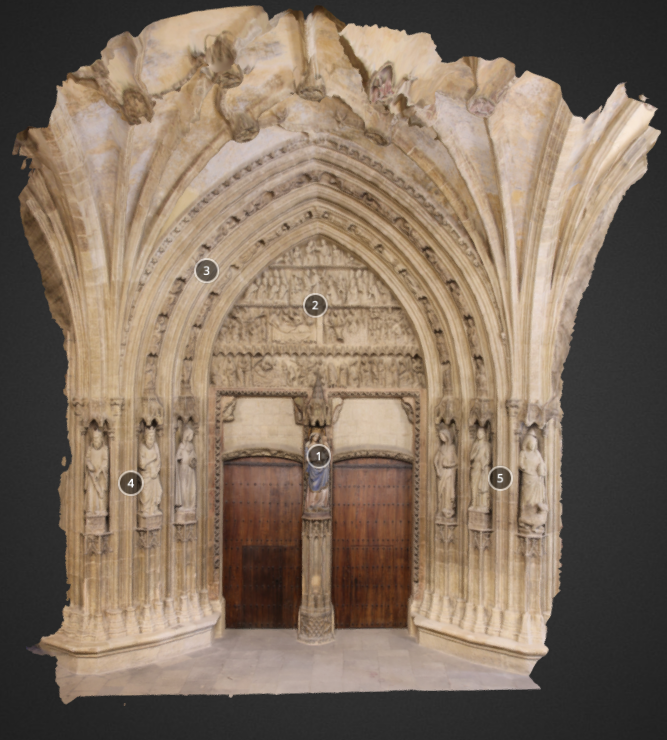
General Romanesque Spain

Please click here to access the site and find out more about how to navigate through its wealth of images and information
Portugal
Alcobaça
Beja
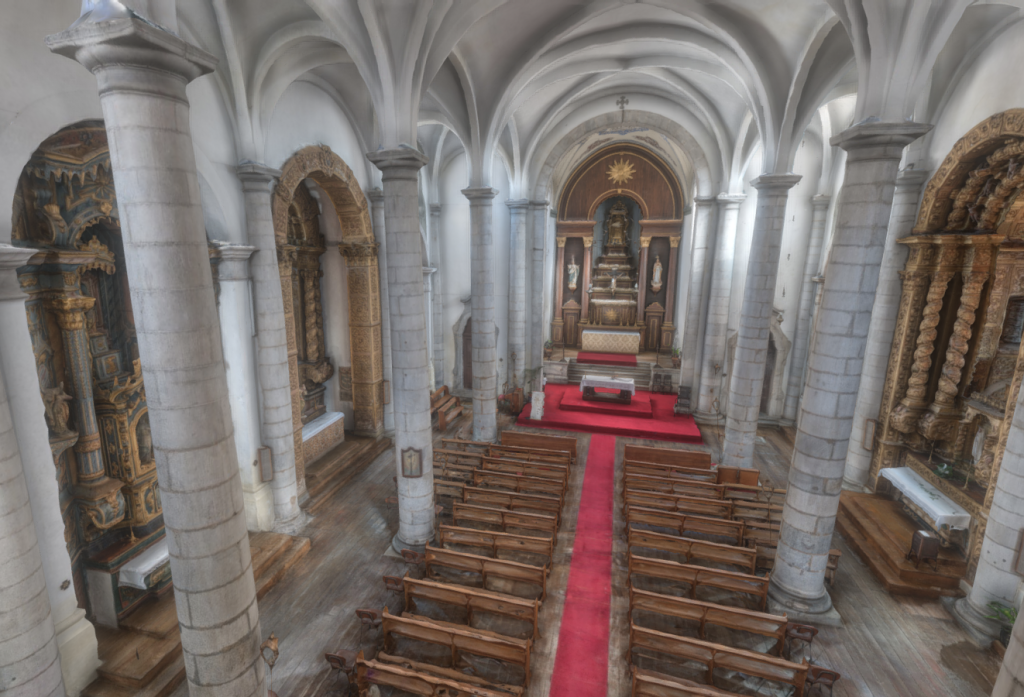
Évora
Holy Trinity from convent of São Domingos of Évora:

Lisbon
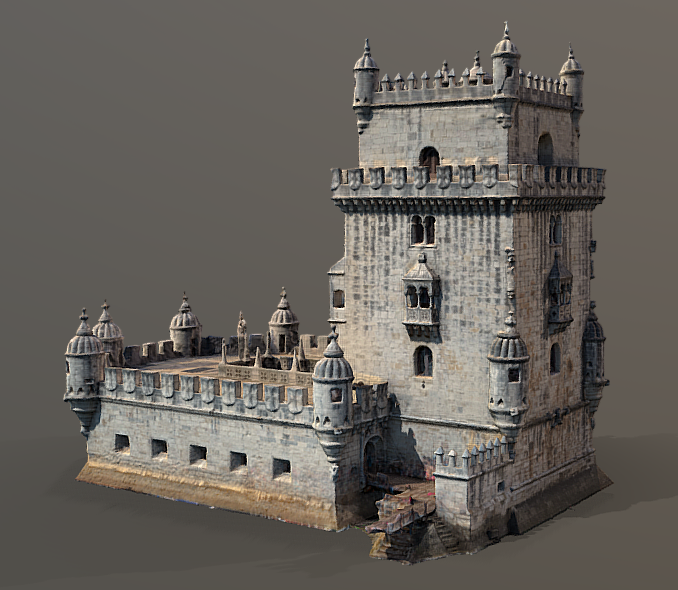
Portal of Santa Maria de Belem:
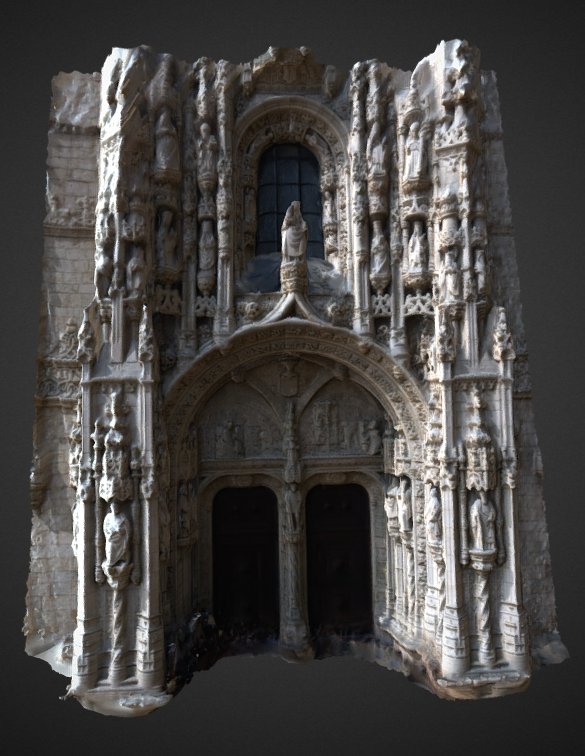
Sintra
